
| WHERE |
The second largest town of the
Caribbeans is the main town of the Isla Grande. Even if it walls would
need some paint the capital evokes his glorious past thanks to the
colonial architecture of the town centre. The town is in the western
part of the island, around a bay; the most famous quarter, la Habana
Vieja is on the west side of the bay. From here, heading west, are
the quarters of Habana Centro, the residential zones of Vedado and
Nuevo Vedado, and the super-residential quartesr of Playa, Miramar,
Siboney, etc, better known as Habana Oeste. |
| A tunnel links Habana Vieja with the east part of town, where working class quarters are, toward south, to the Josè Martì Airport. The most famous beaches, the Playas del Este, are 25km far towards east; wonderful white Caribbean beaches surrounded by some hotels and a few houses, like Guanabo, Santa Maria, Cojimar. |
 |
| TO VISIT |
Habana Vieja
The most ancient quarter, Habana Vieja, was declared World's Heritage by Unesco in 1982 and, since then, a work of restoration of historical buildings has been going on; in spite of that, many buildings are in bad conditions and some of them risk to collapse. The most beautiful buildings are now hotels or museums but the quarter is packed with markets, churches, castles and revolutionary monuments to visit, starting from the Plaza de la catedràl, one of the most beautiful squares in town. |
| The Catedràl
de S. Cristòbal dominates the square, home to a stall market
during the weekend. near the cathedral is the Castillo de la Real
Fuerza, the most ancient colonial building in America. The wind-turner
on the west tower of the castle is known as the Giraldilla, after
Doña Inés de Bobadilla, waiting for her husband, explorer Hernando
de Soto, who left for Florida in search of the fountain of eternal
youth, without returning back to Cuba. |
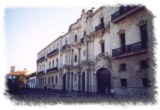 |
|
The Plaza
de Armas, surrounded by palm trees, has been the centre of the Spanish
power (and American afterwards) in Cuba for 400 years. There is a
used-book market in the square and also the Palacio de los Capitanes
Generales, one of the most beautiful buildings turned into a museum,
is on the same square. The most famous street in Habana, the calle
Obispo, starts from the Plaza de Armas to reach the Floridita, Hemingway's
favorite bar; it is a pedestrian road with many bars and paladares. | Habana Centro Habana Centro was, before the Revolution, the red-light district of the Capital; here is the old Parliament (until 1959), the Capitolio Nacional, similar to the one in Washington. On the back you can find the cigar factory Partagas, one of the most ancient in Habana. |
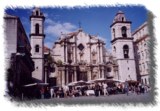 |
Eventually, what
about a walk along the Malecón, the street along the sea?! Mind you
it is very long, so limit your walk to the part adjacent to the Paseo
del Prado.
| Vedado This residential part of town was very popular with mafia mobsters in the 50s; it was built according to Miami's art-deco style, but it had something more: gambling, prostitution and alcohol, until 1959, when Fidel Castro and the barbudos made them flee abroad. |
|
Today's Vedado is a residential
area more relaxed than Haabana Vieja, but still very lively, and it's
a good alternative to the crowded quarters of the centre. Here is
the immense Plaza de la Revolución, ready to be packed with millions
for a speech of the lidér Maximo. If you have some time left,
the cemetery Cristóbal de Colón is worth a visit: it is the burial
ground for many revolutionaries and independence martyrs (but Che
Guevara's tomb is in S.ta Clara).
|
| |
Miramar Miramar is a prestigious residential quarter where many embassies are, luxury shops and some of the best clinics on the island. Not to miss is La Maison mall, gathering place for the fulanos (rich cubans), that can be spot for their Ray-bans and mobile phones. If you are a cold-war lover here you can find the Museum of the Ministerio de Interior, showing all the tricks used by the CIA to try to kill Fidèl Castro. The Marina Hemingway every year hosts the Ernest Hemingway International Marlin Fishing Tournament. |
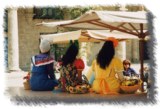 |
| AROUND LA HABANA |
| Regla |
The old town of Regla is home to the Afro-Cuban Religion and to the male secret society of Abakúa. Some famous babalawo (the Saneria priests) live in Regla and will e happy to give suggestions on your future, in Spanish: it's a good habit to leave an offer. The church of Nuestra Señora de Regla is famous for its Black Virgin; she's linked to the Yemayá, the spirit of the Ocean, and protects sailors. To reach Regla, there's a regular ferry service from the Habana port every 10 minutes. |
| Cojimar |
On the road to Playas
del Este, the via Monumentàl, 10km from Habana, is the small
fisherman village of Cojimar. It was Ernest Hemingway's fishing games
starting point in the 40s and 50s and here he had the inspiration
for his novel "The old man and the
sea". It is possible to visit the Torrejon de Cojimar,
a Spanish fort dating back to 1650, and the monument dedicated to
the American writer. |
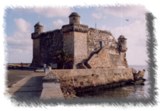 |
| San Francisco de Paula |
|
15km south-east of Habana is the
villa where Hemingway spent part of his life, called Finca la Vigía,
now home to Hemingway's museum. Even if the museum might be closed,
the park surrounding it is worth a visit, like the cemetery of the
writer's dogs and the boat Pilàr, in the villa's garden.
|
| HISTORY |
| la Habana was founded
on the bay in 1519; even if a bit far from the Oriente Province, more
developed at the time, was a perfect spot for Spanish fleet that were
heading Spain from Mexico or South America and was declared capital
of Cuba in 1906. During the war of 7 days, the town was under siege
by the English for 11 months and was freed only after the Spanish
gave-up to Florida's possessions. After this episode, it became the
most fortified town of the Spanish colonial empire; it was also declared
tax free zone, contributing to a rapid growth and economic development
in the 18th and 19th century. |
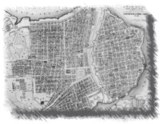 |
Habana was never involved in the
Independence War that shook the Spanish Empire in the 18th century,
being one of the most well preserved towns of the whole south-America.
In 1900 Habana was the favorite destination of the American jet-set
and of many mafia mobsters during the prohibition years in the US;
here rum, cigars and beautiful women where not forbidden. Habana saw
the constructions of many luxury hotels and the invasion of Detroit-made
American cars. |
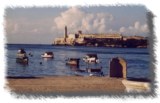 |
On new Year's Eve of 1959 Fidel
Castro and other rebels put a halt to this: gambling, racial segregation,
prostitution were declared illegal and Habana's rich class was forced
to a voluntary exile. All this was replaced , with the help of URSS,
by schools and hospitals, investments in research and arts, with good
and bad results, under everybody's eyes.
|
MAIN EVENTS |
The Habana Carnival, at the end
of February, has street parades in front of the Capitolio and along
the Malecón on friday, Saturday and Sunday. Every year the Jazz International
Festival (in February) and the Guitar Internationl Festival (in May)
are held alternatively. In the same manner, the Caribbean Culture
Festival (June) and the International Theatre Festival are held alternatively
each year. In December is held, each year, the International Festival
of the new Latin-American Cinema. |
| National
Holidays Janauary 1st - Liberation day May 1st - Worker's day July 25th to 27th - National Rebellion Anniversary October 10th - Day of Cuban Culture December 25th - Christmas (re-introduced after Pope's visit in 1997) |
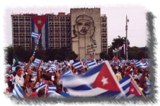 |
EAT OUT |
There is a good choice of Paladares, but also many state-run restaurants; for both, the quality of food and service, like the ambiance, can vary a lot: here's a suggested shortlist of paladares, but the picture is changing rapidly. |
|
|
| Habana Centro Vedado Nuevo Vedado Habana Oeste (Playa y Miramar) |
NIGHT
OUT |
Habana is packed with night life
spots; on the weekly Cartelera you'll find theatre, cinema, art-galleries,
exibitions, bar, nightclubs and cultural events listing. Movies are
usually in original language, and are very common to find foreign
thatre groups at the Teatro Nacional de Cuba, also home to the National
Symphony Orchestra, which has also a good disco-bar, open all night
for salsa lovers. |
| The majority of bar and night-clubs can be found in the quarters of Havana Vieja and Vedado. The Bodeguita del Medio, a few step from the Plaza de la Catedral, is a must and its walls are covered with graffiti together with Hemingway, Allende, Nat King Cole, Fidel Castro and other famous people's autograph. El Floridita, another Hemingway's favourites, is the bar that created the Daiquiri. The most famous night-club in Habana is the Tropicana, where each night 200 dancers with high heels and glittering dresses can be seen: proper attire is required, so no shorts or t-shirt. |
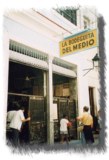 |
WHERE TO SLEEP |
The best way (and the most flexible and cheap) to enjoy the real Habana and its atmosphere is to rent a house, a Casa Particular (a fully licensed house for tourist rental - similar to Bed & Breakfast) offering night stay at very competitive prices. You can choose a house shared with the Cuban family or full privacy option; look for the house in Habana that better satisfies your needs: browse our directory of casas ! |
| | |
| | |